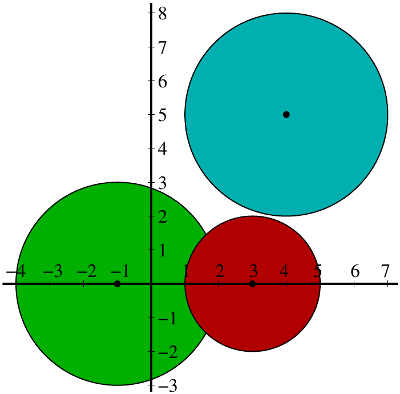My friend Dennis The recently gave a new description of the Lie algebra of
E 8\mathrm{E}_8 (as well as all the other complex simple Lie algebras, except
𝔰𝔩(2,ℂ)\mathfrak{sl}(2,\mathbb{C})) as the symmetries of a system of partial differential equations. Even better, when he writes down his PDE explicitly, the exceptional Jordan algebra makes an appearance, as we will see.
This is a story with deep roots: it goes back to two very different models for the Lie algebra of G 2\mathrm{G}_2, one due to Cartan and one due to Engel, which were published back-to-back in 1893. Dennis figured out how these two results are connected, and then generalized the whole story to nearly every simple Lie algebra, including E 8\mathrm{E}_8.
Let’s begin with that model of G 2\mathrm{G}_2 due to Cartan: the Lie algebra 𝔤 2\mathfrak{g}_2 is formed by the infinitesimal symmetries of the system of PDE
u xx=13(u yy) 3,u xy=12(u yy) 2. u_{x x} = \frac{1}{3} (u_{y y})^3, \quad u_{x y} = \frac{1}{2} (u_{y y})^2 .
What does it mean to be an infintesimal symmetry of a PDE? To understand this, we need to see how PDE can be realized geometrically, using jet bundles.
A jet bundle over ℂ 2\mathbb{C}^2 is a bundle whose sections are given by holomorphic functions
u:ℂ 2→ℂ u \colon \mathbb{C}^2 \to \mathbb{C}
and their partials, up to some order. Since we have a 2nd order PDE, we need the 2nd jet bundle:
J 2(ℂ 2,ℂ) ↓ ℂ 2
\begin{matrix}
J^2(\mathbb{C}^2, \mathbb{C}) \\
\downarrow \\
\mathbb{C}^2
\end{matrix}
This is actually the trivial bundle whose total space is ℂ 8\mathbb{C}^8, but we label
the coordinates suggestively:
J 2(ℂ 2,ℂ)={(x,y,u,u x,u y,u xx,u xy,u yy)∈ℂ 8}. J^2(\mathbb{C}^2, \mathbb{C}) = \left\{ (x,y,u,u_x,u_y, u_{x x}, u_{x y}, u_{y y}) \in \mathbb{C}^8 \right\} .
The bundle projection just picks out (x,y)(x,y).
For the moment, u xu_x, u yu_y and so on are just the names of some extra coordinates and have nothing to do with derivatives. To relate them, we choose some distinguished 1-forms on J 2J^2, called the contact 1-forms, spanned by holomorphic combinations of
θ 1 = du−u xdx−u ydy, θ 2 = du x−u xxdx−u xydy, θ 3 = du y−u xydx−u yydy.
\begin{array}{rcl}
\theta_1 & = & d u - u_x d x - u_y d y, \\
\theta_2 & = & d u_x - u_{x x} d x - u_{x y} d y, \\
\theta_3 & = & d u_y - u_{x y} d x - u_{y y} d y .
\end{array}
These are chosen so that, if our suggestively named variables really were partials, these 1-forms would vanish.
For any holomorphic function
u:ℂ 2→ℂ u \colon \mathbb{C}^2 \to \mathbb{C}
we get a section j 2uj^2 u of J 2J^2, called the prolongation of uu. It simply takes those variables that we named after the partial derivatives seriously, and gives us the actual partial derivatives of uu in those slots:
(j 2u)(x,y)=(x,y,u(x,y),u x(x,y),u y(x,y),u xx(x,y),u xy(x,y),u yy(x,y)). (j^2 u) (x,y) = (x, y, u(x,y), u_x(x,y), u_y(x,y), u_{x x}(x,y), u_{x y}(x,y), u_{y y}(x,y) ) .
Conversely, an arbitrary section ss of J 2J^2 is the prolongation of some uu if and only if it annihilates the contact 1-forms. Since contact 1-forms are spanned by θ 1\theta_1, θ 2\theta_2 and θ 3\theta_3, it suffices that:
s *θ 1=0,s *θ 2=0,s *θ 3=0. s^\ast \theta_1 = 0, \quad s^\ast \theta_2 = 0, \quad s^\ast \theta_3 = 0 .
Such sections are called holonomic. This correspondence between prolongations and holonomic sections is the key to thinking about jet bundles.
Our PDE
u xx=13(u yy) 3,u xy=12(u yy) 2 u_{x x} = \frac{1}{3} (u_{y y})^3, \quad u_{x y} = \frac{1}{2} (u_{y y})^2
carves out a submanifold SS of J 2J^2. Solutions correspond to local holonomic
sections that land in SS. In general, PDE give us submanifolds of jet spaces.
The external symmetries of our PDE are those diffeomorphisms of J 2J^2 that send contact 1-forms to contact 1-forms and send SS to itself. The infinitesimal external symmetries are vector fields that preserve SS and the contact 1-forms. There are also things called internal symmetries, but I won’t need them here.
So now we’re ready for:
Amazing theorem 1.
The infinitesimal external symmetries of our PDE is the Lie algebra 𝔤 2\mathfrak{g}_2.
Like I said above, Dennis takes this amazing theorem of Cartan and connects it to an amazing theorem of Engel, and then generalizes the whole story to nearly all simple complex Lie algebras. Here’s Engel’s amazing theorem:
Amazing theorem 2.
𝔤 2\mathfrak{g}_2 is the Lie algebra of infinitesimal contact transformations on a 5-dim contact manifold preserving a field of twisted cubic varieties.
This theorem lies at the heart of the story, so let me explain what it’s
saying. First, it requires us to become acquainted with contact geometry, the
odd-dimensional cousin of symplectic geometry. A contact manifold MM is a
(2n+1)(2n+1)-dimensional manifold with a contact distribution CC on it. This is a
smoothly-varying family of 2n2n-dimensional subspaces C mC_m of each tangent space T mMT_m M, satisfying a certain nondegeneracy condition.
In Engel’s theorem, MM is 5-dimensional, so each C mC_m is 4-dimensional. We can projectivize each C mC_m to get a 3-dimensional projective space ℙ(C m)\mathbb{P}(C_m) over each point. Our field of twisted cubic varieties is a curve in each of these projective spaces, the image of a cubic map:
ℂℙ 1→ℙ(C m). \mathbb{C}\mathbb{P}^1 \to \mathbb{P}(C_m) .
This gives us a curve 𝒱 m\mathcal{V}_m in each ℙ(C m)\mathbb{P}(C_m), and taken together this is our field of twisted cubic varieties, 𝒱\mathcal{V}. Engel gave explicit formulas for a contact structure on ℂ 5\mathbb{C}^5 with a twisted cubic field 𝒱\mathcal{V} whose symmetries are 𝔤 2\mathfrak{g}_2, and you can find these formulas in Dennis’s paper.
How are these two theorems related? The secret is to go back to thinking about jet spaces, except this time, we’ll start with the 1st jet space:
J 1(ℂ 2,ℂ)={(x,y,u,u x,u y)∈ℂ 5}. J^1(\mathbb{C}^2, \mathbb{C}) = \left\{ (x, y, u, u_x, u_y) \in \mathbb{C}^5 \right\} .
This comes equipped with a space of contact 1-forms, spanned by a single 1-form:
θ=du−u xdx−u ydy. \theta = d u - u_x d x - u_y d y .
And now we see where contact 1-forms get their name: this contact 1-form defines a contact structure on J 1J^1, given by C=ker(θ)C = \mathrm{ker}(\theta).
Many of you may know Darboux’s theorem in symplectic geometry, which says that any two symplectic manifolds of the same dimension look the same locally. In contact geometry, the analogue of Darboux’s theorem holds, and goes by the name of Pfaff’s theorem. By Pfaff’s theorem, there’s an open set in J 1J^1 which is contactomorphic to an open set in ℂ 5\mathbb{C}^5 with Engel’s contact structure. And we can use this map to transfer our twisted cubic field 𝒱\mathcal{V} to J 1J^1, or at least an open subset of it. This gives us a twisted cubic field on J 1J^1, one that continues to have 𝔤 2\mathfrak{g}_2 symmetry.
We are getting tantalizingly close to a PDE now. We have a jet space J 1J^1, with some structure on it. We just lack a submanifold of that jet space. Our twisted cubic field 𝒱\mathcal{V} gives us a curve in each ℙ(C m)\mathbb{P}(C_m), not in J 1J^1 itself.
To these ingredients, add a bit of magic. Dennis found a natural construction that takes our twisted cubic field 𝒱\mathcal{V} and gives us a submanifold of a space that, at least locally, looks like J 2(ℂ 2,ℂ)J^2(\mathbb{C}^2, \mathbb{C}), and hence describes a PDE. This PDE is the G 2\mathrm{G}_2 PDE.
It works like this. Our contact 1-form θ\theta endows each C mC_m with a symplectic structure, dθ md\theta_m. Starting with our contact structure, CC, this symplectic structure is only defined up to rescaling, because CC determines θ\theta only up to rescaling. Nonetheless, it makes sense to look for subspaces of C mC_m that are Lagrangian: subspaces of maximal dimension on which dθ md\theta_m vanishes. The space of all Lagrangian subspaces of C mC_m is called the Lagrangian-Grassmannian, LG(C m)\mathrm{LG}(C_m), and we can form a bundle
LG(J 1) ↓ J 1
\begin{matrix}
\mathrm{LG}(J^1) \\
\downarrow \\
J^1 \\
\end{matrix}
whose fiber over each point is LG(C m)LG(C_m). It turns out LG(J 1)LG(J^1) is locally the same as J 2(ℂ 2,ℂ)J^2(\mathbb{C}^2, \mathbb{C}), complete the with latter’s complement of contact 1-forms.
Dennis’s construction takes 𝒱\mathcal{V} and gives us a submanifold of LG(J 1)\mathrm{LG}(J^1), as follows. Remember, each 𝒱 m\mathcal{V}_m is a curve in ℙ(C m)\mathbb{P}(C_m). The tangent space to a point p∈𝒱 mp \in \mathcal{V}_m is thus a line in the projective space ℙ(C m)\mathbb{P}(C_m), and this corresponds to 2-dimensional subspace of the 4-dimensional contact space C mC_m. This subspace turns out to be Lagrangian! Thus, points pp of 𝒱 m\mathcal{V}_m give us points of LG(C m)LG(C_m), and letting mm and pp vary, we get a submanifold of LG(J 1)LG(J^1). Locally, this is our PDE.
Dennis then generalizes this story to all simple Lie algebras besides 𝔰𝔩(2,ℂ)\mathfrak{sl}(2,\mathbb{C}). For simple Lie groups other than those in the AA and CC series, there is a homogenous space with a natural contact structure that has a field of twisted varieties living on it, called the field of “sub-adjoint varieties”. The same construction that worked for G 2\mathrm{G}_2 now gives PDE for these. The AA and CC cases take more care.
Better yet, Dennis builds on work of Landsberg and Manivel to get explicit descriptions of all these PDE in terms of cubic forms on Jordan algebras! Landsberg and Manivel describe the field of sub-adjoint varieties using these cubic forms. For G 2\mathrm{G}_2, the Jordan algebra in question is the complex numbers ℂ\mathbb{C} with the cubic form
ℭ(t)=t 33. \mathfrak{C}(t) = \frac{t^3}{3} .
Given any Jordan algebra WW with a cubic form ℭ\mathfrak{C} on it, first polarize ℭ\mathfrak{C}:
ℭ(t)=ℭ abct at bt c, \mathfrak{C}(t) = \mathfrak{C}_{abc} t^a t^b t^c ,
and then cook up a PDE for a function
u:ℂ⊕W→ℂ. u \colon \mathbb{C} \oplus W \to \mathbb{C} .
as follows:
u 00=ℭ abct at bt c,u 0a=32ℭ abct bt c,u ab=3ℭ abct c, u_{00} = \mathfrak{C}_{abc} t^a t^b t^c, \quad u_{0a} = \frac{3}{2} \mathfrak{C}_{a b c} t^b t^c, \quad u_{a b} = 3 \mathfrak{C}_{a b c} t^c ,
where t∈Wt \in W, and I’ve used the indices aa, bb, and cc for coordiantes in WW, 0 for the coordinate in ℂ\mathbb{C}. For G 2\mathrm{G}_2, this gives us the PDE
u 00=t 33,u 01=t 22,u 11=t, u_{00} = \frac{t^3}{3}, \quad u_{01} = \frac{t^2}{2}, \quad u_{11} = t ,
which is clearly equivalent to the PDE we wrote down earlier. Note that this PDE is
determined entirely by the cubic form ℭ\mathfrak{C} - the product on our Jordan
algebra plays no role.
Now we’re ready for Dennis’s amazing theorem.
Amazing theorem 3.
Let W=ℂ⊗𝔥 3(𝕆)W = \mathbb{C} \otimes \mathfrak{h}_3(\mathbb{O}), the exceptional Jordan
algebra, and ℭ\mathfrak{C} be the cubic form on WW given by the determinant. Then
the following PDE on ℂ⊕W\mathbb{C} \oplus W
u 00=ℭ abct at bt c,u 0a=32ℭ abct bt c,u ab=3ℭ abct c, u_{00} = \mathfrak{C}_{abc} t^a t^b t^c, \quad u_{0a} = \frac{3}{2} \mathfrak{C}_{a b c} t^b t^c, \quad u_{a b} = 3 \mathfrak{C}_{a b c} t^c ,
has external symmetry algebra 𝔢 8\mathfrak{e}_8.
Acknowledgements
Thanks to Dennis The for explaining his work to me, and for his comments on drafts of this post.
. In this post I’d like to record an elementary argument, making no use of generating functions, giving a lower bound of the form
for some
, which might help explain intuitively why this exponential-of-a-square-root rate of growth makes sense.
as a Young diagram of size
, or equivalently (in French coordinates) as a lattice path from somewhere on the y-axis to somewhere on the x-axis, which only steps down or to the right, such that the area under the path is
. Heuristically, if the path takes a total of
steps then there are about
such paths, and if the area under the path is
then the length of the path should be about
, so this already goes a long way towards explaining the exponential-of-a-square-root behavior.
and ending at
where
is a positive integer to be determined later. Suppose that the steps of the lattice paths alternate between paths of the form (down, right, right, down) and (right, down, down, right), which means that
is even. Then the area under the path is exactly the area of the right triangle it approximates, which is
, and the number of such paths is exactly
. This gives
, so we get a lower bound of the form
where
, quite a bit worse than the correct value
. This bound generalizes to all values of
with only a small loss in the exponent because
is nondecreasing (since the lattice path can continue along the line
for awhile at the end before hitting the x-axis).
.
. With a more convex curve we can afford to make the path longer while fixing the area under it.
as follows. Rather than count
directly, we will count
, so the number of lattice paths with area at most
. Since
is increasing, it must be at least
times this count. And we have much more freedom to pick a path now that we only need to bound its area rather than find it exactly. We can now take the path to be any Dyck path from
to
, of which there are
denotes the Catalan numbers and the asymptotic can be derived from Stirling’s approximation. The area under a Dyck path is at most
, which gives the lower bound
(so that
),
where
, a substantial improvement over the previous bound. Although we are now successfully in a regime where our counts include paths of a typical shape, we’re overestimating the area under them, so the bound is still not as good as it could be.





 My
My 


 Lamenting that the legislative process is too "tedious," New York Gov. Andrew Cuomo issued an executive order Sunday that will punish private firms for engaging in anti-Israel activism.
Lamenting that the legislative process is too "tedious," New York Gov. Andrew Cuomo issued an executive order Sunday that will punish private firms for engaging in anti-Israel activism. 
